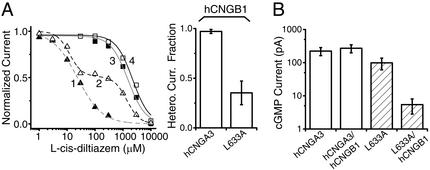Figure 3.
The CLZ domain is critical for preferential formation of A/B heteromers. (A) l-cis-Diltiazem block of hCNGA3 and its point mutant L633A, either expressed alone or coexpressed with hCNGB1. (Left) The representative dose–response relations from one experiment: curves 1–4 are those of hCNGA3/hCNGB1, L663A/hCNGB1, hCNGA3, and L663A, respectively. (Right) The averaged fraction of total current from heteromeric channels for hCNGA3 and L633A coexpressed, respectively, with hCNGB1 (see below for fitting method and values). The data for hCNGA3 and L633A expressed alone were fitted with the ORIGIN program (Microcal Software, Northampton, MA) by the Hill equation, I = Imax[K1/2n/(K1/2n + Cn)]. (Left) The fitting parameters were K1/2 = 1.52 mM, n = 1.40 (hCNGA3), and K1/2 = 2.22 mM, n = 1.46 (L633A). Means (±SEM) from five patches were K1/2 = 2.28 ± 0.28 mM, n = 1.34 ± 0.09 (hCNGA3) and K1/2 = 1.69 ± 0.37 mM, n = 1.46 ± 0.22 (L633A). The data in the presence of hCNGB1 were fitted with a linear combination of two Hill equations, I = f[K1/2n/(K1/2n + Cn)] + (1 − f)[K′1/2n′/(K′1/2n′ + Cn′)], with the five parameters optimized to provide the best fit. (Left) The optimized parameters are f = 1, K1/2 = 23.6 μM, n = 0.99 for hCNGA3/hCNGB1, and f = 0.48, K1/2 = 12.2 μM, n = 1.94, K′1/2 = 1.38 mM, n′ = 1.91 for L633A/hCNGB1. The mean values (±SEM) for heteromers (four patches each) are f = 0.97 ± 0.02, K1/2 = 27.0 ± 2.3 μM, n = 0.94 ± 0.03, K′1/2 = 4.65 ± 0.39 mM, n′ = 5.49 ± 2.49 for hCNGA3/hCNGB1, and f = 0.35 ± 0.12, K1/2 = 22.6 ± 6.5 μM, n = 1.42 ± 0.33, K′1/2 = 2.00 ± 0.36 mM, n′ = 1.68 ± 0.18 for L633A/hCNGB1. Note that K′1/2 and n′ values for hCNGA3/hCNGB1 are rough because the homomer fraction is too small. (B) Macroscopic (saturated) cGMP-activated currents for hCNGA3 and its point mutant L633A, either expressed alone or coexpressed with hCNGB1. A total of 0.1 μg of each cDNA was transfected. Mean currents (±SEM) are 223 ± 61 pA (13 patches, hCNGA3), 272 ± 74 pA (13 patches, hCNGA3/hCNGB1), 99 ± 38 pA (14 patches, L633A), and 5.4 ± 2.6 pA (13 patches, L633A/hCNGB1). Although more channels might be expected from the same amount of transfected hCNGA3 cDNA in the presence of hCNGB1 than in its absence, the current was not significantly larger in the former case, presumably because of the flickery openings of the heteromeric channels and therefore smaller effective single-channel currents (13).

